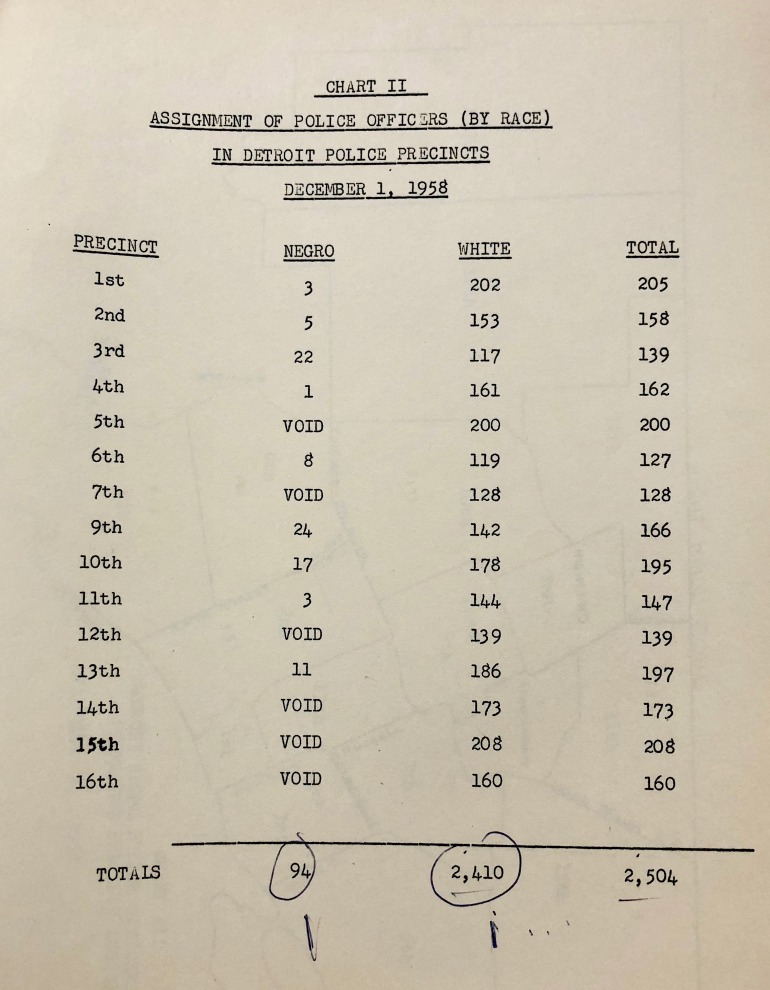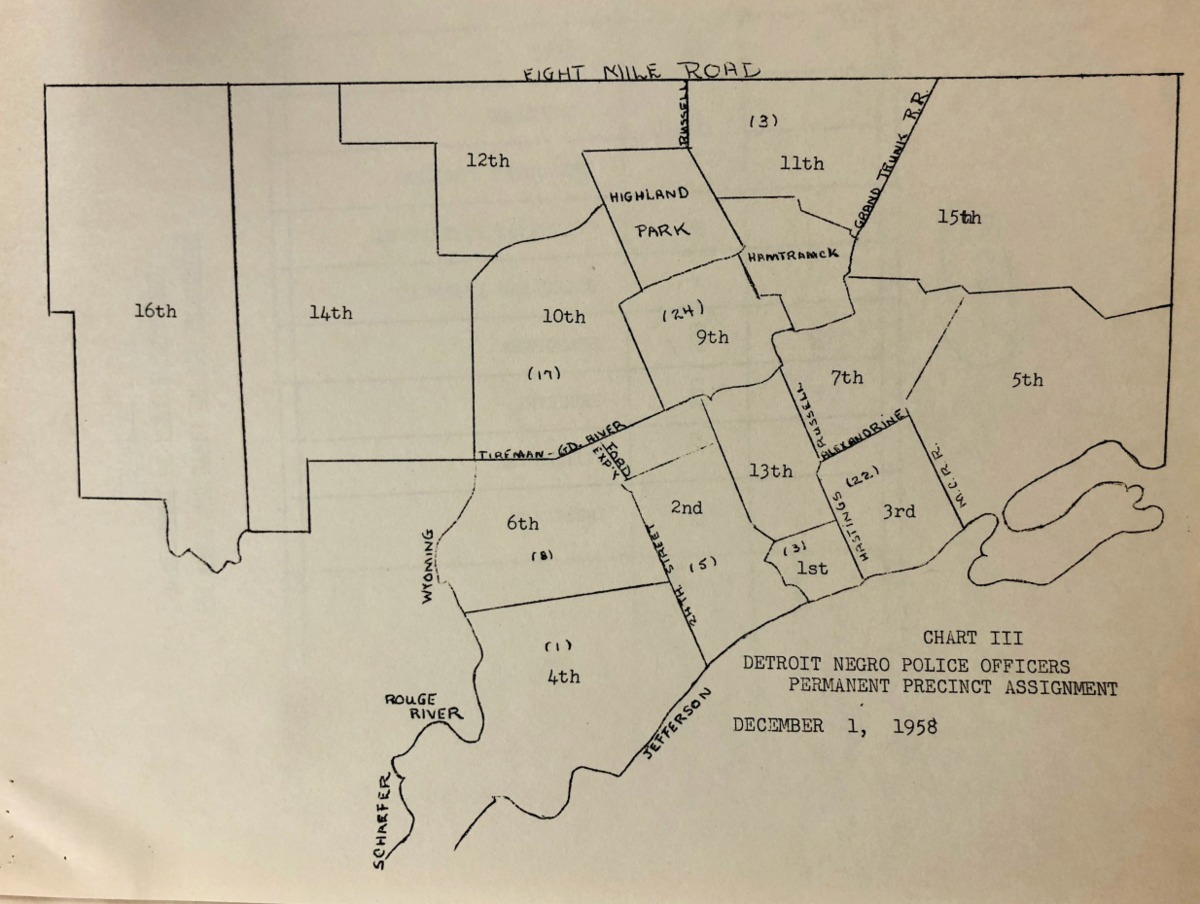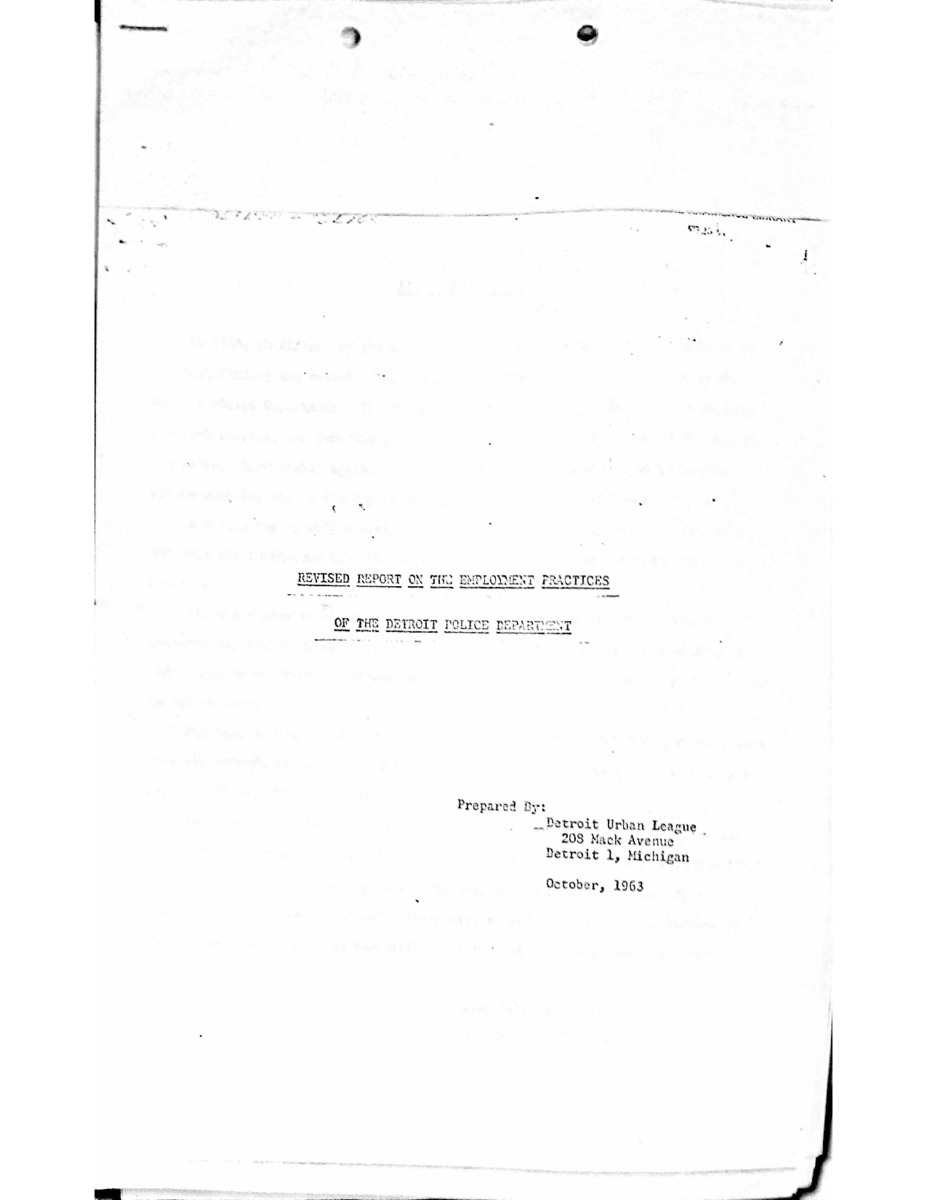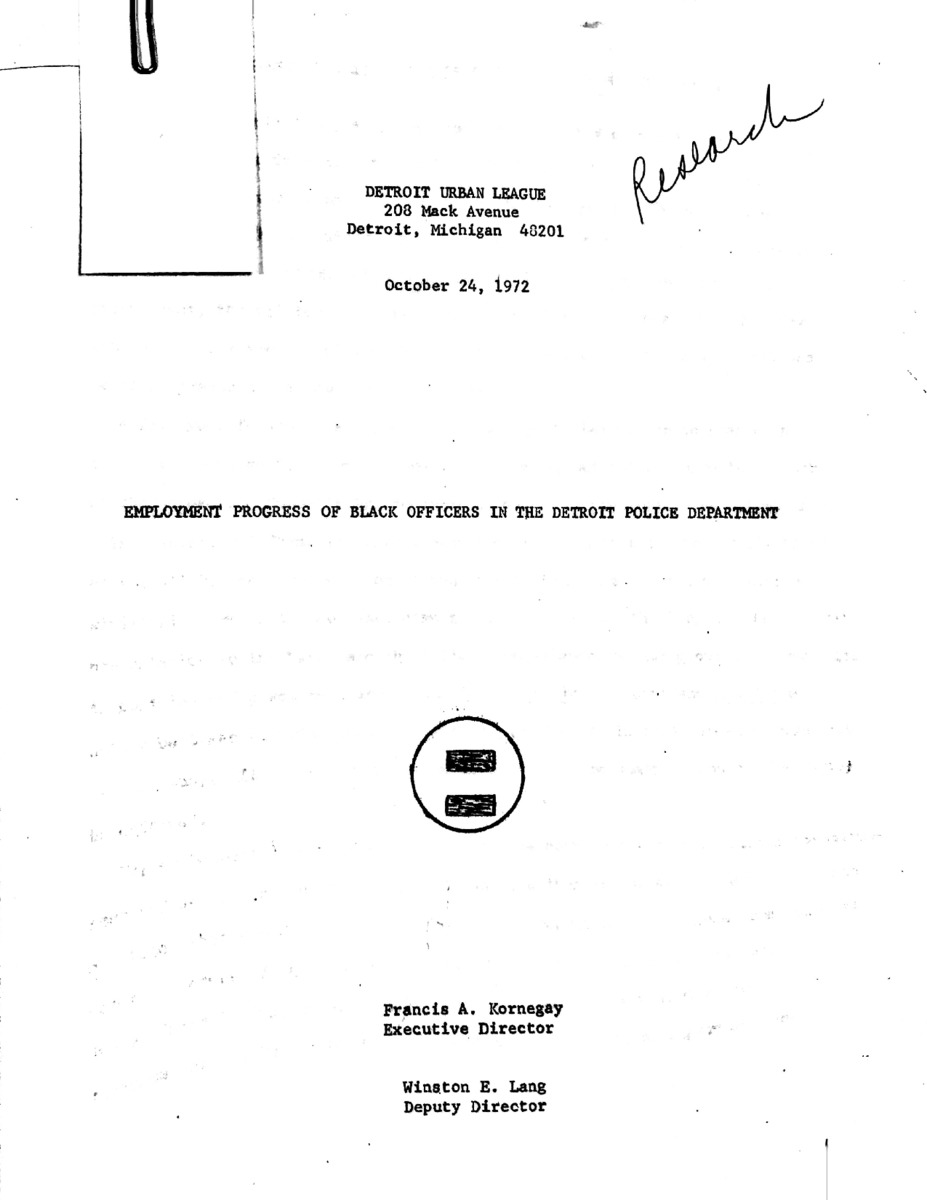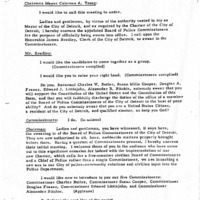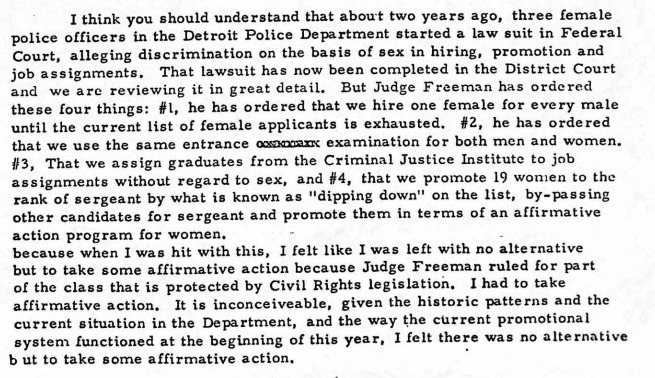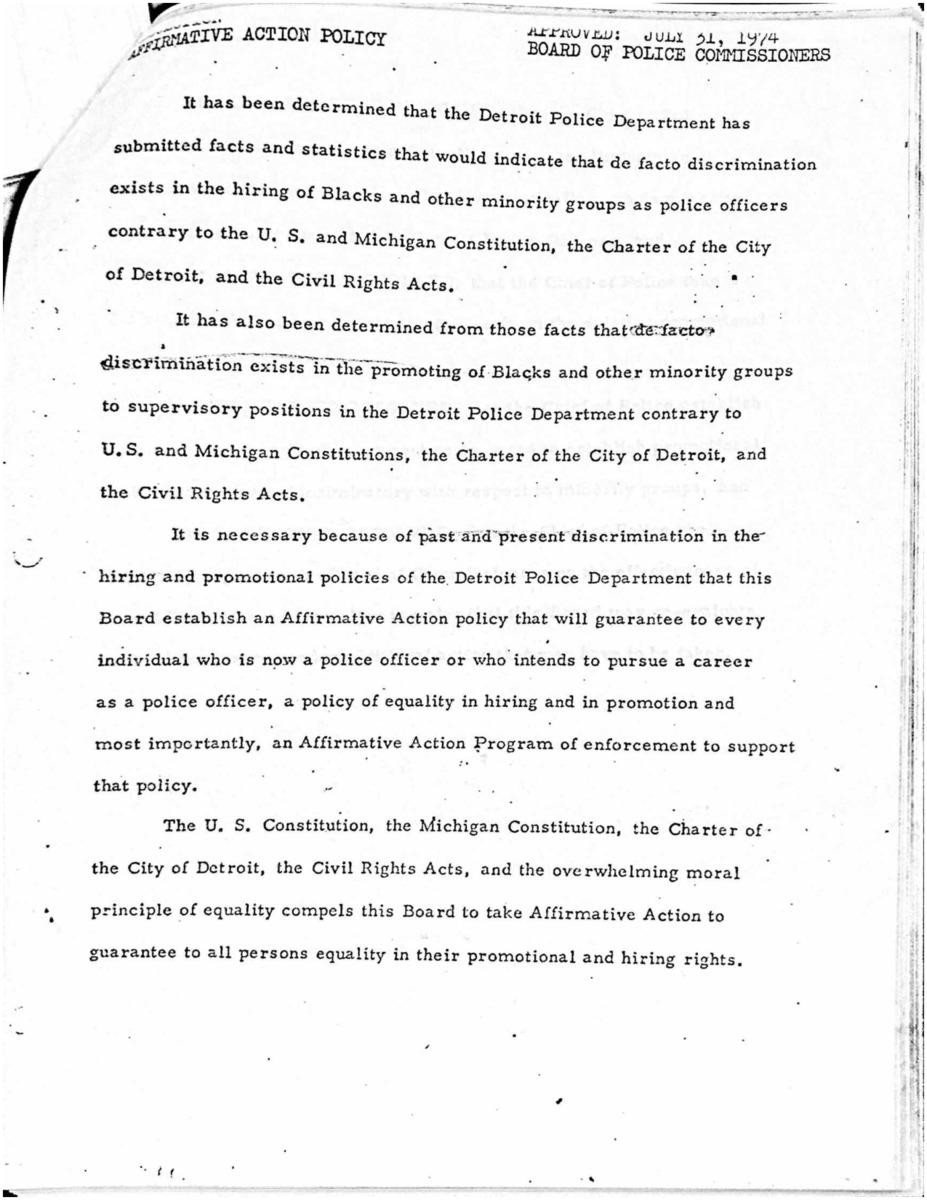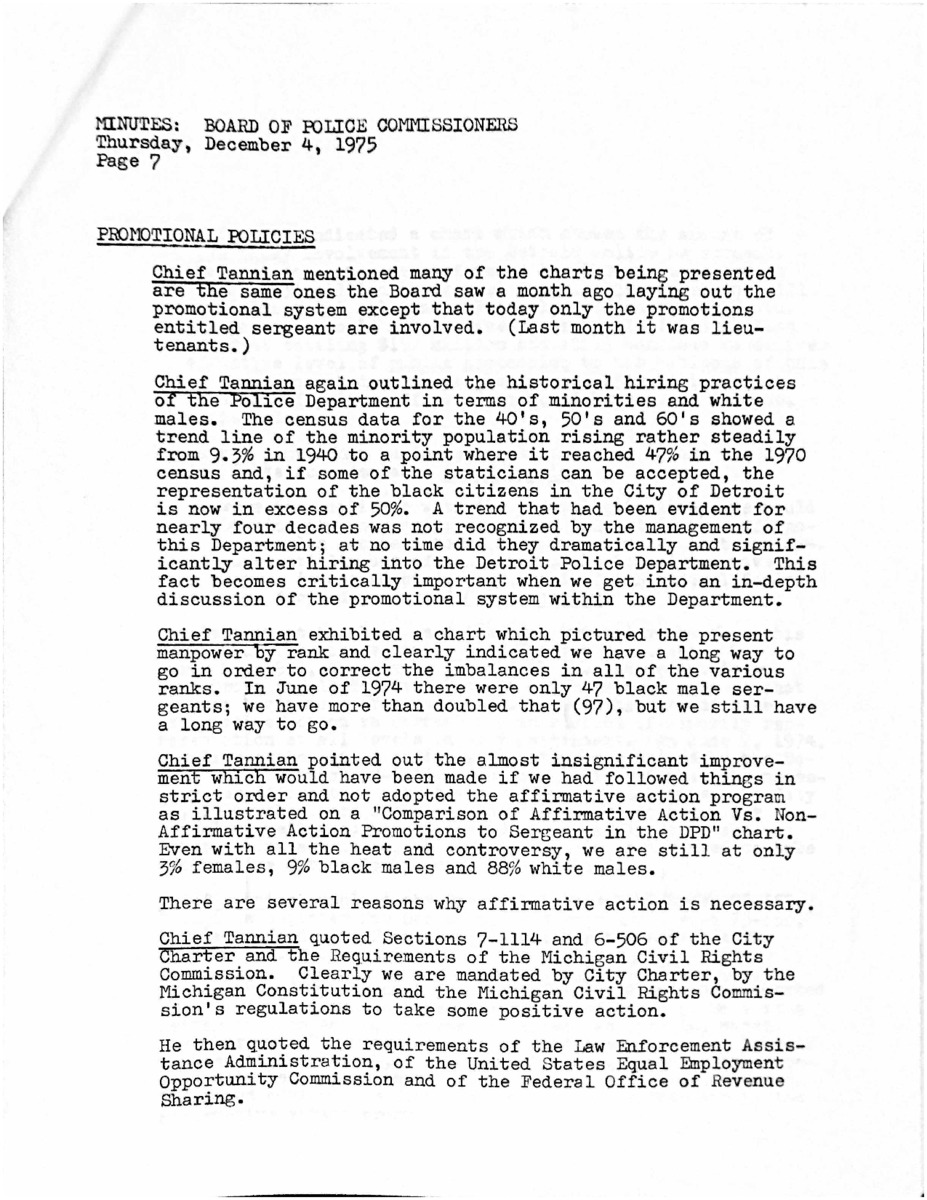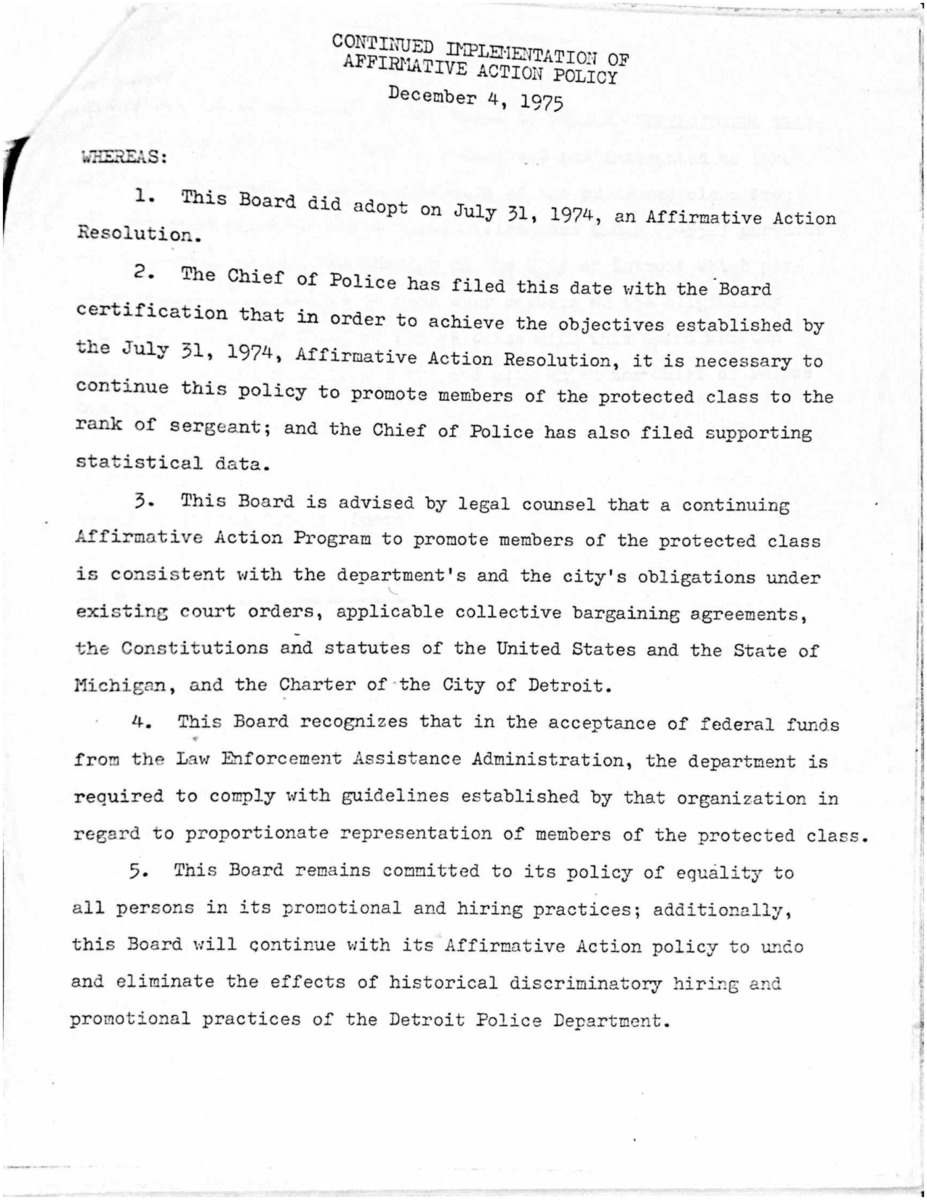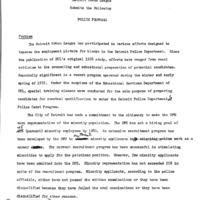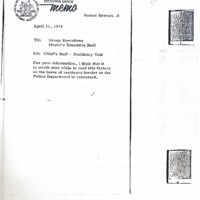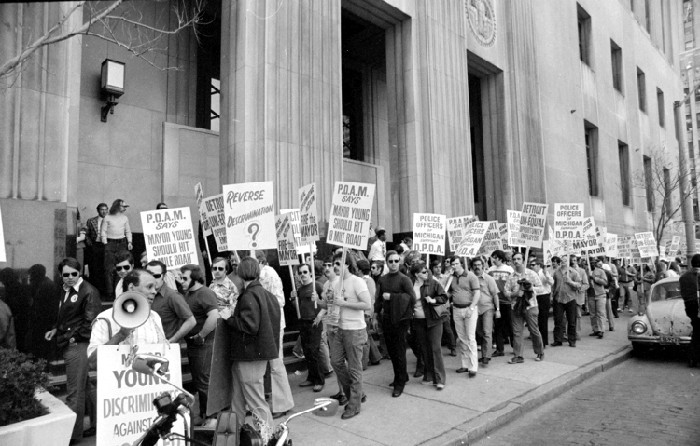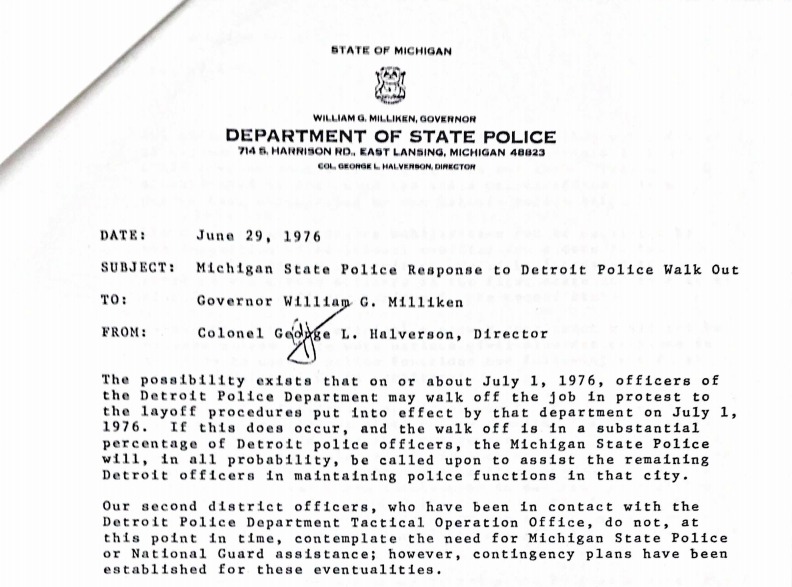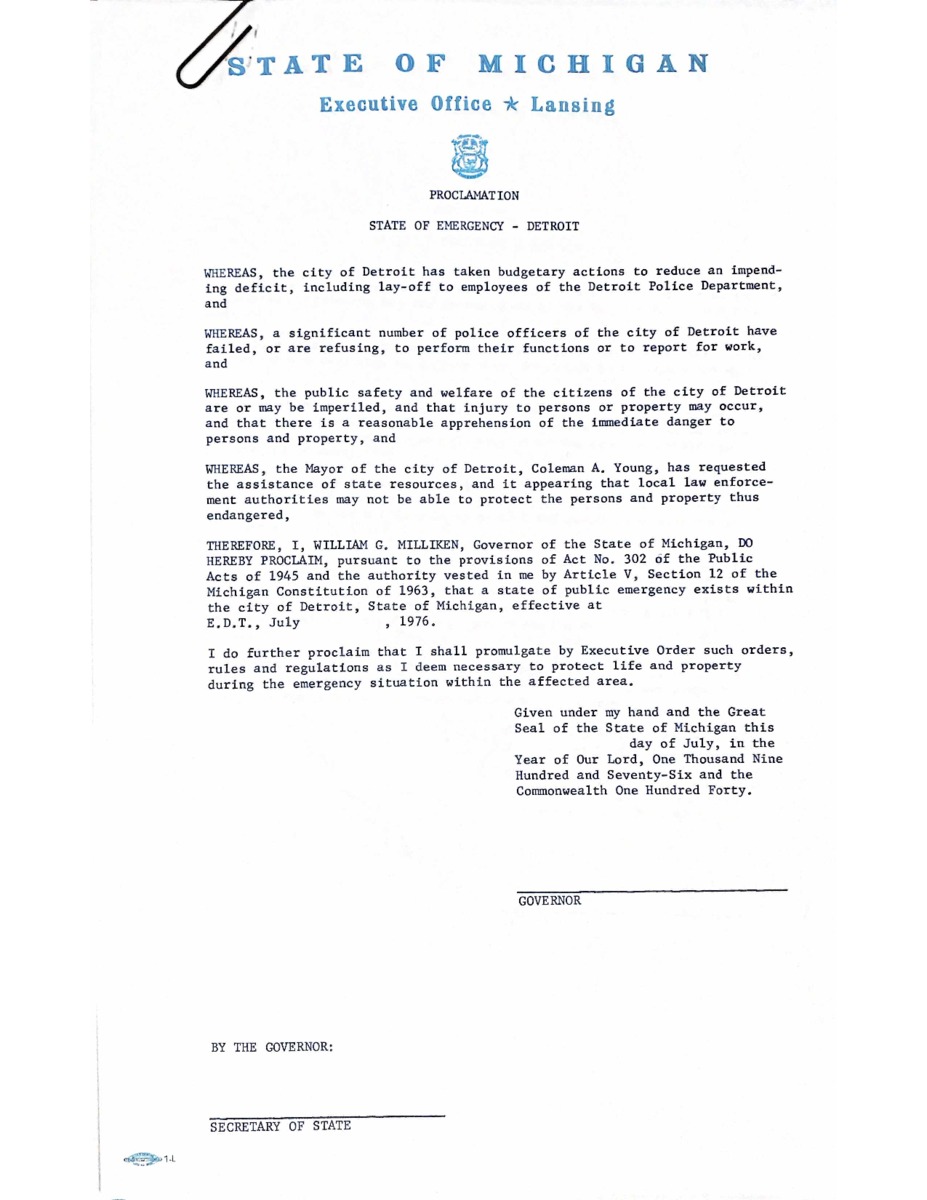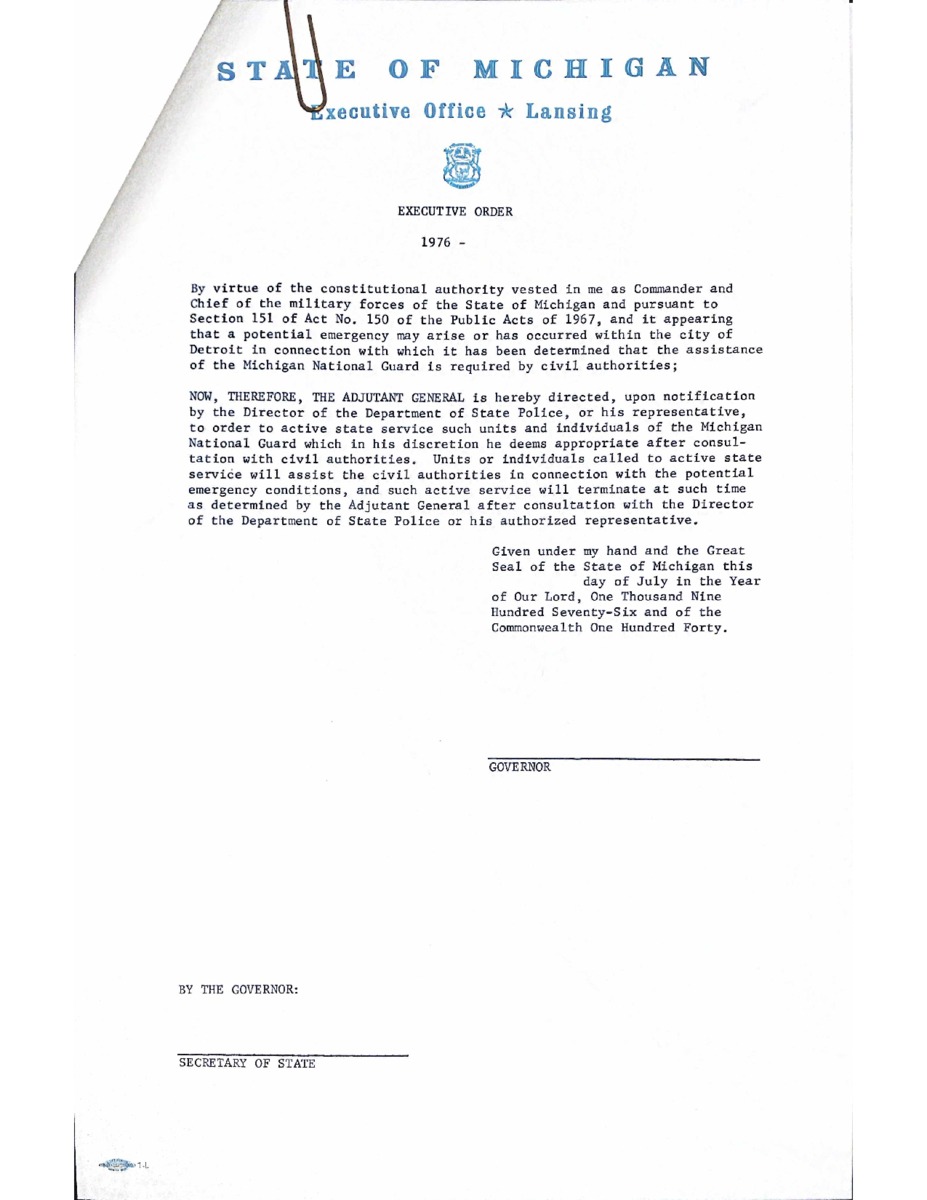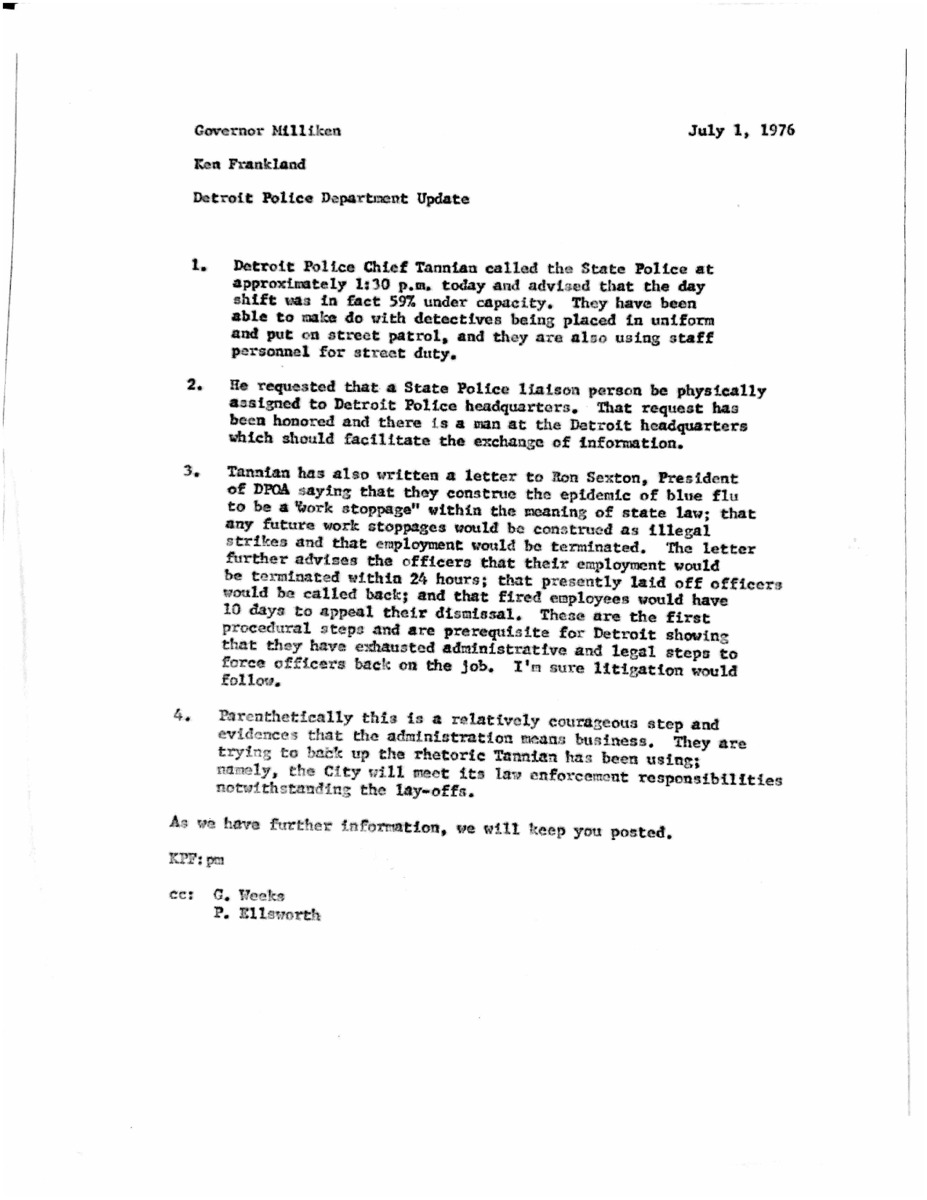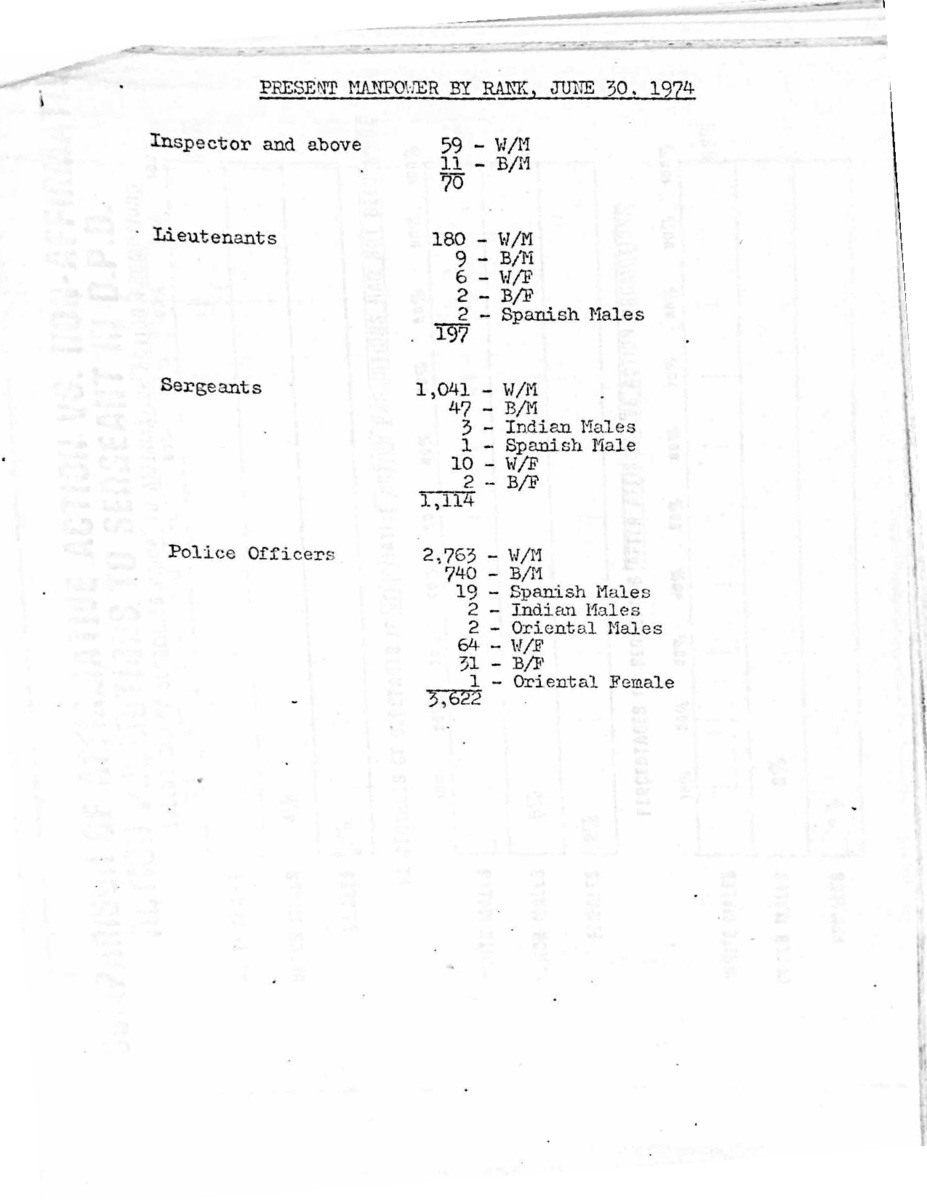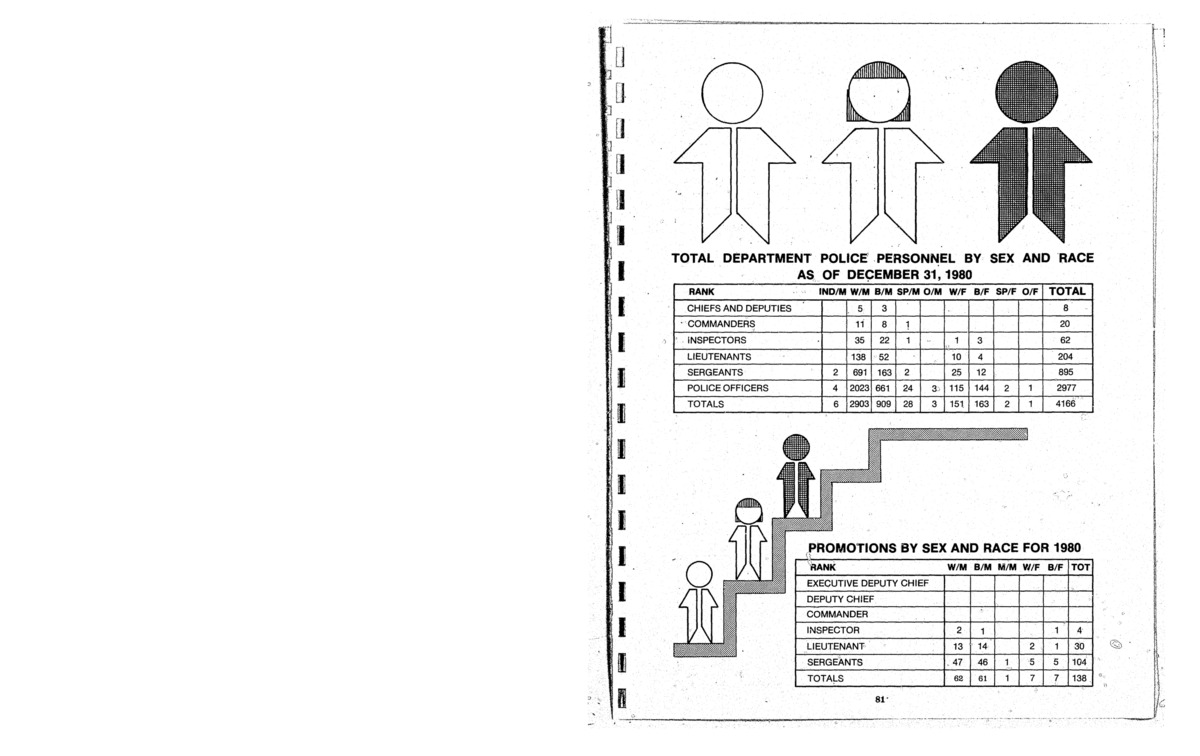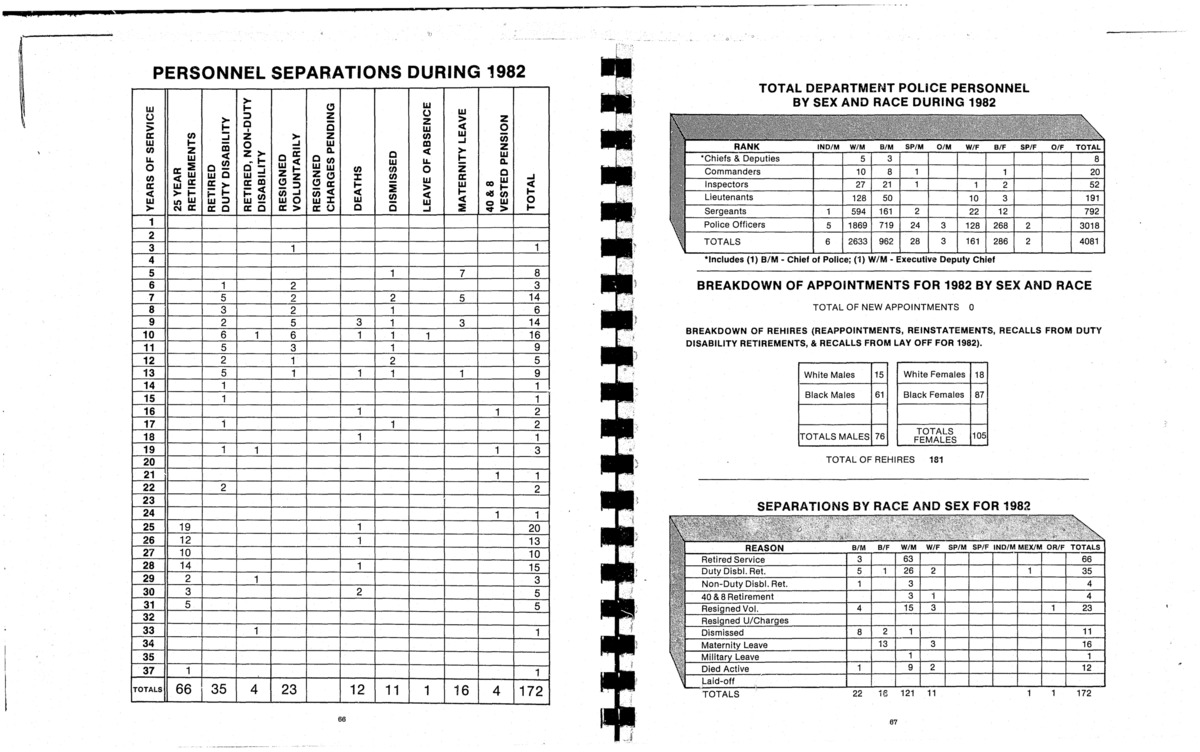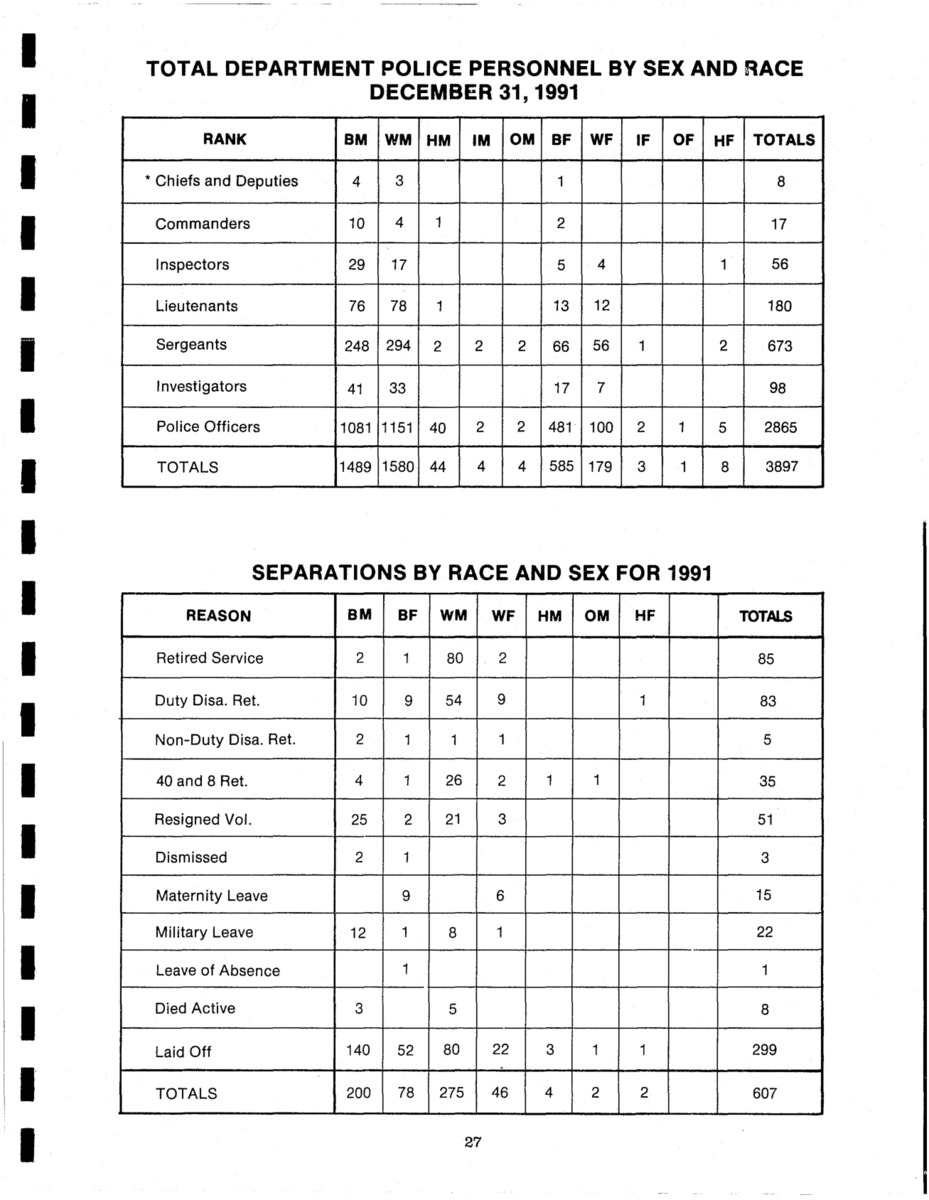Reform and Resistance
Calls For Change
Civil rights groups and activists in Detroit had been calling for police reform in the city throughout the first half of the 20th century. In the 1950s and 60s, in the contexting of a national civil rights movement that was gaining steam, black activists in Detroit intensified their efforts to bring justice to the Detroit Police Department (DPD). On of the major reforms being pushed for at that time was to change the discriminatory hiring and promotional practices of the DPD. By doing so, reform groups and activists hoped they could diversify the majority white police force so that it would better reflect the demographics of the city as a whole. It was thought that changing the force's composition would also help improve strained police-community relations in the city. To black activists at the time, imporoving police-community relations meant decreasing instances of racialized police burutality that were all to frequent during the 50s and 60s. In 1958 and again in 1963, the Detroit Urban League (DUL) released reports analyzing the disparities between the number of white and black police officers. The reports found evidence of sistemic discriminatory practices withn the DPD and called for changes in police policy to help better integrate the police force and to ensure equal access to higher ranked positions.
Calls for affirmative action within the DPD, as well as for police reform as a whole, were given new creedence and a new sense of urgency after black residents took to the streets in response to police violence in 1967. That 1967 uprising prompted renewed cries from community activists and civil rights organizations to implement changes in the police department in order to reduce the impression among many citizens that the majority white police force constituted a sort of “occupying army” when operating in the majority black neighborhoods of Detroit. Over the summer of 1968, with the image of the 1967 unrest still fresh on the minds of Detroit’s leadership, the percent of new DPD officers that were black jumped from under 20% to almost 45%. Unfortunately, that increase did not fully last. During the next few years, under the administration of Mayor Roman Gribbs and Police Commissioner John F. Nichols, and despite continued efforts to hire more blacks, the percent of African Americans among new officers fell back down to less than 30%, much less than was needed to match the demographics of the force to those of the city. Due to the lack of new black officers, the DPD remained much more white than the city it policed.
In 1972 the Detroit Urban League (DUL) released another report on the hiring practices of the DPD. The 1972 report optimistically made note of the positive changes that had occured in regards to DPD hiring practices since the 1967 uprising. More specifically, the report commended the city for having increased the number of black officers, especially within the higher ranks of the Department. However, the DUL report also emphasized the fact that the Department remained whiter than the city's overall population and that black officers continued to face discriminatory challanges. Just like the two reports that came before it, the 1972 DUL analysis of DPD hiring provided major evidence of systemic discrimination against black applicants to the police force. The report showed that, although there were approximately even numbers of black and white applicants, black applicants were more than 2½ times less likely than white applicants to be accepted onto the force. The report linked that fact to the importance of the highly subjective “written evaluation” portion of the hiring process, which black applicants were twice as likely to fail. The report also critiqued the Department's assignment and promotional practices as allowing for the inclusion of racist biases and being overly reliant on seniority, a factor which overwhelmingly favored white officers. The 1972 DUL report argued that although progress had been made, much more work was needed. The report's summary, quoted below, encapsulates that argument.
In 1974 Coleman Young became Detroit’s first African American mayor after running largely on a platform of police reform. From the onset of his first term, Young dedicated much of his political energy to achieving demographic representation within the police department through intensified affirmative action measures aimed at bringing more African Americans and women into the DPD. However, Young’s reforms would suffer several setbacks, largely caused by budget problems as well as the extreme resistance of the white male establishment within the DPD, before they were to be fully realized. Over the course of his administration, Young was quickly forced to come to terms with the reality expressed by the Detroit Urban League's 1972 warning: "there remain[ed] much work to be accomplished in the Detroit Police Department".
Affirmative Action Under Coleman Young
In 1974, the same year that Coleman Young was elected mayor, Detroit voters approved a new city charter that, among other things, provided for the creation of a citizen board of police commissioners to oversee the DPD and greatly expanded mayoral powers in regards to the management of the department. The newly elected Mayor Young used both of those changes to help institute a dramatic intensification of the city’s efforts to integrate the DPD. A transcript of the very first meeting of the new Board of Police Commissioners, held on July 22nd of 1974, demonstrates the centrality of affirmative action within Young’s agenda of police reforms. Even prior to that first Board of Commissioners meeting, Young had issued an executive order compelling the DPD to attempt to reach a 50/50 split between white and black officers within four years. At the meeting itself, the first order of business undertaken by the commissioners, after their swearing in and their agreement to set meeting times and procedure, was a thorough examination of the need for affirmative action. The Chief of Police at the time, Philip G. Tannian, gave the freshly inaugurated board members a detailed presentation on the issue of affirmative action. Tannian, along with Mayor Young, who was also in attendance at the meeting, made a strong case for the board to create affirmative action policies designed to hire and promote more African Americans and women, citing past hiring discrimination, continued de facto discrimination within the promotional system, as well as legal mandates from ongoing lawsuits and civil rights legislation.
One compelling reason for affirmative action, according to Tannian, was a court order produced as the result of a lawsuit against the DPD filed by three female officers. Prior to 1974, women in the DPD were restricted to the department’s “Women’s Division”, paid less than their male counterparts, and denied promotional opportunities. In Schaefer v. Tannian, the case referenced by Tannian in his presentation, a Michigan District Court judge ruled that the city had an obligation to remedy its past discrimination through affirmative action. More specifically, the city was obliged to hire one female applicant for every male applicant, and to promote a certain number of female officers even if there were male officers who had higher scores in promotional evaluations. The Schaefer v. Tannian decision was significant beyond its direct policy requirement on the city’s hiring and promotion of women. In the years after Schaefer, the Young administration developed strikingly similar policies to help diminish the legacies of discrimination against African Americans in addition to women. The specific strategy of instituting equal hiring and promotional rates for blacks and whites as well as males and females, regardless of evaluation score, would become the cornerstone of Mayor Young’s contentious affirmative action program within the DPD.
Mayor Young, along with the Board of Police Commissioners wasted little time in bringing their vision of affirmative action into political reality. On July 31st, 1974, just a week after their first meeting, the Board of Police Commissioners adopted a resolution ordering Chief Tannian to implement affirmative action in the hiring and promotion of minorities, and to take further steps to eliminate discrimination in the preexisting criterea for hiring and promotions. By December of the following year, the DPD had created a policy ensuring the promotion of an equal number of black and white officers. Prior to the Young administration, officers were listed in the order of the scores they received on promotional evaluations, and promotions were awarded to those on top of the list. Under the new policy, black and white candidates above a certain benchmark score were ranked on two seperate lists. Each time a candidate was selected for a promotion from the top of the white list, another candidate was also selected from the top of the black list. That system was eventually expanded to include white and black women in the order of promotions.
The city also took steps to increase black hiring, including by actively recruiting from black communities within Detroit. According to Mayor Young, the DPD would routinely send patrol cars to predominantly black neighborhoods with the express purpose of seeking new recruits. Young had previously been involved in a promotional campaign featuring Bill Cosby, developed in the aftermath of the 1967 uprising, which attempted to get more African Americans to apply to the police department. As Mayor, Coleman Young stepped up efforts to recruit more black officers and was fairly succesful in doing so; the percent of black DPD applicants rose by 25% during Young's first two years in office.
Recruitment efforts on there own, however, were innefective. As pointed out by the Detroit Urban League a 1973 policy proposal, prior recruitment efforts had been largely futile; Although they were able to increase the number of minority applicants, racially discriminatory hiring practices prevented major gains in the compisition of the DPD as a whole. because of that barrier, the Young administration changed the hiring protocols themselves in an attempt to root out discriminatory elements such as culturally biased evaluations.
Another major policy move made at the very beginning of Young’s first mayor term was the strict enforcement of the city’s residency requirement. Detroit had for many years required city employees, including police officers, to live within city limits. Prior to Mayor Young’s entry into office the rule had gone more or less unenforced. Concerned with the understanding among some black Detroiters that the police represented an occupying army, Young's administration added a Residency Unit to DPD which was tasked with enforceing the requirement. The Residency Unit operated by identifying and investigating officers who violated the statute and having them removed from the police force if they failed to move within the city’s boundaries. By actually enforcing the city's residency rule Young hoped to promote more engagement between police officers and Detroit’s citizens and to make room for officers, especially black officers, who actually came from the communities they would be in charge of policing.
Resistance
It quickly became clear to Mayor Young’s administration that the implamentation of their affirmative action program within the police department would not be as easy as they might have initially conceived. By the summer of 1975, only a year after Young assumed office and barely six months after the new Board of Police Commissioners issued its first affirmative action resolution, two massive and interconnected obstacles began to appear, almost simultaneously: budget problems and police union lawsuits. Neither barrier was particularly unexpected. Detroit had been suffering from the economic burdens of white flight and de-industrialization since at least the mid sixties, and a 1973-74 oil embargo had severely deepened economic woes in the auto-industry dependent city. Legal resistance from the cities two police unions, the Detroit Police Officers Association (DPOA) and the Detroit Police Lieutenants and Sergeants Association (DPLSA), was also relatively predictable, given that both were comprised almost entirely of white, male police officers who could be passed over for promotions under Young’s affirmative action program.
More surprising was the way in which the two problems coincided and combined to form a massive barrier against Young’s goal of a representative DPD.
By mid 1975, both the DPLSA and the DPOA had filed lawsuits against Mayor Young, the DPD, and the city of Detroit itself, alleging that the affirmative action program was unconstitutional and violated labor agreements. Adding to the program's problems was Detroit's economic crisis. In the summer of 1975, facing a massive budget deficit and unwilling to plunge the city into the uncertainty of debt, Coleman Young made the tough decision to make large cuts to the Detroit’s municipal workforce, including laying off hundreds of police officers. Those layoffs presented yet another challenge for the besieged Mayor and the DPD. Traditionally, layoffs had been made in strict order of seniority, the last to have been hired were the first to go. If Young was to proceed with his proposed layoffs in the traditional manner, he would be forced to erase many of the gains his affirmative action policies had created over the previous year. If Young refused to abide by the traditional seniority rule, he was sure to provoke costly lawsuits and other forms of resistance from the white police unions. It seemed for a moment that the administration had worked themselves into an impossible catch-22.
Coleman Young, however, was committed to balancing the budget. In the spring of 1975 he announced the layoffs of more than 800 police officers. In an attempt to defend his affirmative action gains while following the seniority firing rule, Young had created a plan to rehire over 275 black and female officers, who’s positions were funded through federal grants, the month after layoffs were to take place. The DPOA, opposed to the idea of any layoffs, chose to bring yet another suit against the city, challenging their legitimacy. On May 9th, 1975, despite a large DPOA protest which ended in violence against a black officer, District Judge Ralph Freedman ruled that the layoffs could proceed. In another win for the Young administration, Freedman also ruled that the city would not have to fire the 275 black and female officers whose positions were funded through federal Comprehensive Employment and Training Act grants.
Although Freedman’s ruling was a victory for affirmative action, the 505 remaining layoffs were still supposed to be carried out in order of seniority. Young had another policy maneuver up his sleeve, however, in order to avoid the negative outcome that the seniority rule would have for black and female representation in the DPD. Young decided to prioritize the layoffs of officers who had been found to violate the city's residency requirement. Since the vast majority of DPD officers living outside city limits was white, this move gave even further room to protect the jobs of African American officers while still making the cuts he needed to balance the city budget.
Young’s success in protecting affirmative action in 1975 led to an even greater intensification of resistance from white police officers and the DPOA. In the summer of 1976, in reaction to further proposed layoffs prioritizing residency rule violators, many white police officers chose to participate in a “Blue Flu” style strike. Police were legally barred from striking due to their role in maintaining public safety. Because of that officers would sometimes call in sick en masse as a kind of informal strike often called a “Blue Flu”. The 1976 “Blue Flu” started in the end of June and lasted until July 2nd when Chief of Police Philip Tannian threatened to fire any officer involved in the informal strike. On July 1st, the height of the strike’s intensity, almost 60% of the force failed to come into work, leaving the department precariously understaffed. The strike was so bad that the city was forced to ask Michigan’s Governor at the time, William Milliken, to draft an executive order that would have declared a state of emergency in the city and deployed state police as well as the national guard to help maintain order. Fortunately, Chief Tannian and the DPD were able to boost the number of officers in the streets by temporarily reassigning officers in administrative positions to patrol the streets. Governor Milliken avoided having to declare a state of emergency and send in reinforcements. The severity of the Blue Flu strike in 1976 clearly demonstrates both the intensity of white, male officer’s resistance to affirmative action, as well as the way in which budget problems and layoffs lead to massive escalations of that resistance.
Prior to and throughout the course of the affirmative action program, the DPD was infested with a racist culture that made life difficult and sometimes dangerous for the growing number of black officers on the force. A plethora of examples of the ways individual racist white police officers resisted working with African Americans can be found in the experiences of former Detroit Police Chief Ike McKinnon. Isaiah “Ike” McKinnon was a police officer in Detroit from 1965 to 1984 and was appointed Chief of Police in 1994. In the selected interview clips shown below, McKinnon’s stories of rampant racism and discrimination within the DPD provide a glimpse into the hostile environment that black officers were forced to work in during the late 1960s and early 1970s.
As a young officer, McKinnon dealt with overtly racist peers and an administration that was extremely reluctant to punish officers for their racist actions. Officers routinely refused to speak with McKinnon and made racist comments while he was within earshot. Later in the interview, McKinnon recounts how affirmative action policies created even greater hostilities between white and black officers. McKinnon’s experiences show how resistance to affirmative action was not limited to lawsuits, strikes, and protests. Individual white officers also played a role in resisting the full integration of the DPD through racist actions which excluded and intimidated African American officers in an attempt to make it difficult for them to remain in the department.
Getting Results
Despite the best efforts of Mayor Young, the Chief of Police, and the Board of Police Commissioners, budget problems and lawsuits still put a significant hamper on the city's ability to improve the racial and gender demographics of its police force. Losses in lower courts, the inability to hire new officers, as well as the reluctance of individual white officers to work with black men and women all helped to slow the rate at which the city could enact its program of affirmative action. More budget problems in 1978 and 1979 led to additional layoffs and prompted further DPOA resistance and “Blue Flu” strikes. Although Young had originally sought to achieve a 50-50 racial split by 1978, as late as 1980 about 70% of the DPD’s employees were still white men. Although the resistance of white DPD officers never succeeded in completely overturning the affirmative action program, it did fundamentally alter course of the policies implamentation and strain city and police resources, through costly legal battles, “Blue Flus”, and the resistance of individual officers.
Over the course of the 70s and 80s the demographics of the department did gradually move closer to those of the city as a whole. Although there were some setbacks in the lower courts, the city eventually won its legal struggles with the two police unions over the legality of the affirmative action program. By the time a federal appellate court made a final ruling in favor of the city in 1993, Detroit had for the first time built a demographic split that was almost exactly 50-50. Although that outcome came some fifteen years after Young had initially aimed to achieve it, it was nevertheless an important milestone in the history of policing in Detroit. Without Young’s program it is uncertain if Detroit would have ever developed a police force that was that representative of the city’s racial demographics. Infact, since the end of Detroit’s affirmative action program, the demographics of the police force have failed to keep up with those of the city as a whole. According to the The Detroit News, in 2015 the DPD was only 61% black even though the city was by then over 80% African American. The documents below, taken from annual reports issued by the DPD, show how affirmative action had a huge impact on the demographics of the department. It is less obvious, however, how successful the policy was in achieving its other goals, such as creating better police-community relations or improving the effectiveness of the department.
Sources:
Coleman A. Young Papers, Burton Historical Collection, Detroit Public Library.
Francis. A Kornegay Papers, Bentley Historical Library, University of Michigan.
Ernest Goodman Papers, Walter P. Reuther Library, Archives of Labor and Urban Affairs, Wayne State University.
William G. Milliken Papers, Bentley Historical Library, University of Michigan.
Detroit Urban League Records, Bentley Historical Library, University of Michigan.
"Eliot Hall Discuses Police Reform in Detroit Under Mayor Coleman A. Young", The North, Rise Up, Detroit, MI, December 8, 2018.
Detroit Under Fire, Police Brutality and Radicalization, Policing and Social Justice HistoryLab, (2019).
Detroit Police Scooter Officer, Emergency Operator, and Cadet Training (c. 1972), Detroit Historical Society, Detroit, MI.
Margolis, Richard J., Who Will Wear the Badge?, United States Commission on Civil Rights, (Washington, D.C.: GPO, 1971).
Mayor Young Comments to Congress, 1975, WJBK-TV2 News Edison/Mayor, Detroit Historical Society.
Virtual Motor City, Walter P. Reuther Library, Archives of Labor and Urban Affairs, Wayne State University.
Interview of Isaiah "Ike" McKinnon by Matt Lassiter and HistoryLab Team, ed. Zev Miklethun, December 3, 2019, Ann Arbor, MI.
Detroit Free Press, ProQuest Historical Newspapers.
Detroit Police Department, Anual Report, Serial. (DPD, 1970-1981).

